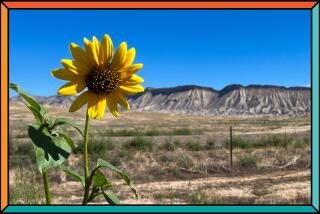A Search for a Plant Blooms Into an Experience of Our Planet
OAXACA JOURNAL
By Oliver Sacks
National Geographic Directions
162 pages, $20
Unhappy at home or bullied at school, some children turn to the world of fantasy for consolation. Others have turned instead to the natural world. Oliver Sacks, who recollected his unhappy school experiences and his early love affair with chemistry in his recent memoir “Uncle Tungsten,” not only grew up to be a prominent clinical neurologist but also a writer with a rare gift for communicating the excitement of science and medicine to the general, nonspecialist reader.
In books such as “Awakenings,” about a group of patients coming back to normal consciousness after suffering from sleeping sickness for decades, “Seeing Voices: A Journey Into the World of the Deaf” and “The Man Who Mistook His Wife for a Hat,” about people afflicted with various neurological disorders from amnesia to aphasia, Sacks has explored the complicated terrain where mind and matter interfuse.
Sacks’ central interest is in the mysteries of the human brain and nervous system. But he is also a keen amateur botanist with a consuming passion for ferns. Ever since boyhood, he confesses, these leafy, green, flowerless plants delighted him “with their curlicues, their crosiers, their Victorian quality (not unlike the frilled antimacassars and lacy curtains in our house). But at a deeper level,” he continues, “they filled me with wonder because they were of such ancient origin. All of the coal that heated our home, my mother told me, was essentially composed of ferns or other primitive plants, greatly compressed.
” ... Ferns had survived, with little change, for a third of a billion years. Other creatures, like dinosaurs, had come and gone, but ferns, seemingly so frail and vulnerable, had survived all the vicissitudes, all the extinctions the earth had known.”
A journey organized by the American Fern Society in search of specimens is what takes Sacks somewhere he has never been before: Oaxaca, Mexico, a destination as rich in archeological and cultural history as in natural history. It is Sacks’ first trip to Mexico. Although he is unfamiliar with the country and can’t speak Spanish, the moment he steps onto the plane taking him there he feels a sense of welcome. The Mexicans he meets strike him as extremely well-informed about their country’s past, both pre- and post-Columbian, and eager to share their knowledge with visitors.
Published in the National Geographic Directions series featuring travel writing by all sorts of prominent literary figures, from Francine Prose on Sicily to A.M. Homes on Los Angeles, “Oaxaca Journal” is Sacks’ relaxed yet observant account of his 10-day fern-finding excursion.
Not surprisingly, he finds a lot more than ferns: teeming marketplaces filled with exotic (to him, anyway) foods; breathtaking Zapotec and Aztec ruins; ornate Roman Catholic churches; fossils that speak of the prehistoric past; and living, breathing human beings who leave just as deep an impression, from a master weaver keeping alive an ancient craft, to Boone Hallberg, a boundlessly knowledgeable and resourceful botanist dedicated to helping the local farmers maintain their autonomy and way of life.
Sacks’ Oaxacan journey sets him thinking about life in all its forms, from the peaceful, purposeful lives of village artisans carrying on an ancient tradition of craftsmanship to the tiny bacteria that are the only organisms on Earth capable of converting atmospheric nitrogen into forms that can be used by the rest of us.
His thoughtful, sometimes wistful ruminations, no matter how expansive they may grow, are always rooted in the concrete details he has observed.
A brilliant red flower sets him thinking of the co-evolution of flowering plants and the insects they attract, and of the red and orange fruits that “seem only to have appeared in the last thirty million years or so, in tandem with the evolution of trichromatic vision in monkeys and apes” who could easily spot them amid the dense green foliage.
His own preference for the flowerless green world of ferns he explains more fancifully: “A world ... with a charming modesty, where reproductive organs--stamens and pistils--are not thrust out flamboyantly but concealed, with a certain delicacy, on the undersides of leafy fronds.” Yet this modesty and simplicity have endured for eons.
Sacks not only delights in the natural and cultural riches of Oaxaca but in the company of his fellow fern enthusiasts. His trip is a true vacation because it provides him with a respite from the competitiveness he encounters in his professional life. Here among the fern lovers, he feels immersed in the genial, open-hearted spirit of amateurism.
When it comes to scientific fieldwork, Sacks reminds us, the observant eye of the amateur can be as important as the trained eye of a professional.
Certainly, those who read “Oaxaca Journal” will appreciate Sacks’ own diligence as an observer and his skill in translating the wonders of the material world into words.


